
If you’ve been thinking about launching a podcast to promote your company or brand online, you’re in good company. What was once considered a fringe medium has grown into a wildly popular channel for marketing and sales.
At face value, launching a podcast might seem as easy as talking about a topic and posting it online, but getting results from your podcast requires strategy.
Just because the medium is inherently informal doesn’t mean your approach to executing it should be.
The most successful podcasts make it look easy because they are created with specific goals in mind, and those goals align with their brand’s overall marketing and sales strategy. Luckily, we’ve got a few podcast experts on our Clariant Creative team who’ve helped break the process down into manageable activities and podcast best practices to consider.
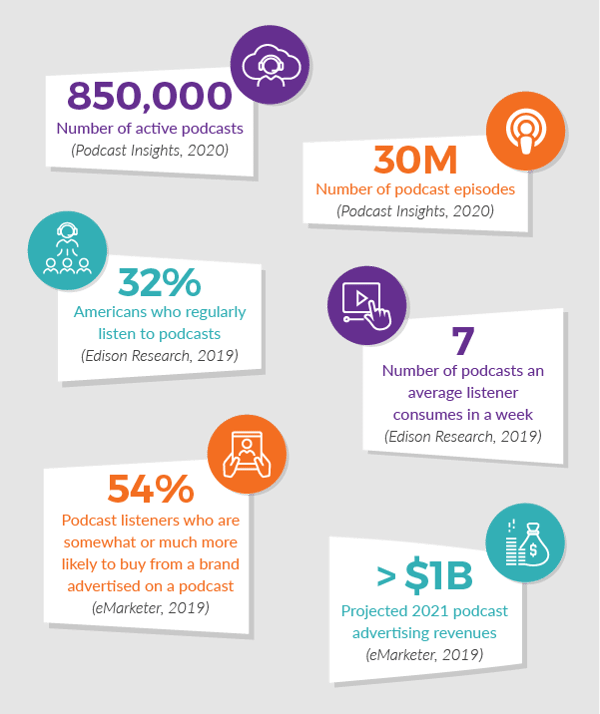
What is a content strategy?
Why is a content strategy important?
How to develop a content marketing strategy
Step 1: Define your goals
Step 2: Develop your buyer personas
Step 3: Map the buyer’s journey
Step 4: Determine your brand voice and tone
Step 5: Conduct a content audit
Step 6: Brainstorm content ideas
Step 7: Identify the types of content to create
Step 8: Document and execute your strategy
Step 9: Measure the ROI of content marketing
Conclusion: Set your business up for success with a content strategy
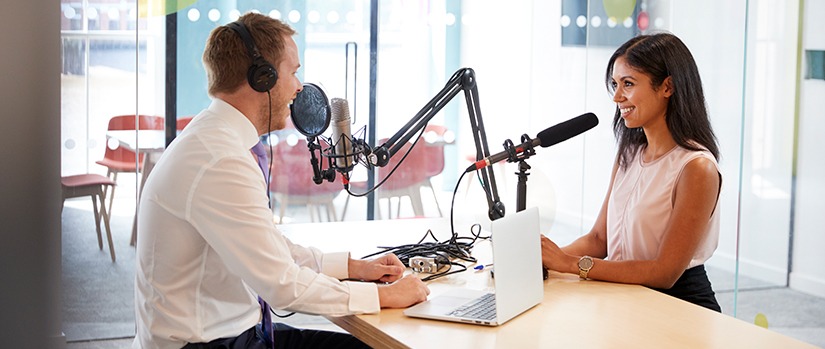
Before diving into the work of launching a podcast, you’ll need to do some planning, just like you would for any marketing tactic. The key here is to make sure you have a clear vision of what your podcast should accomplish, the right resources, and a well-defined approach.
A podcast is an investment in time and resources, so you need to be clear why you’re doing it and if it’s the right medium for what you want to accomplish.
Digital Marketer created a list of the five questions you should ask yourself before your company embarks on the podcast path:
Whether your audience is internal or external, it’s important to find out if they’re interested in a podcast from you. Not sure? Surveys are an excellent way to gauge interest, not only in the podcast itself, but also in potential topics.
To fine-tune your planning, consider creating buyer personas for your desired audience. Buyer personas help you target messaging to your intended customers, so you’ll have the best chance of achieving your goals.
This is tricky for some companies. If you can’t identify how you will demonstrate expertise in this medium, a podcast may not be right for your company. However, if you don’t have much in-house expertise on the topic, but know plenty of people who do, you may be able to rely on guests for your podcast. Be aware, though – if you rely on guests for every episode, that adds a layer of complexity (and a lot more time) to planning.
Podcasts are cool and can very effective, but maintaining a successful podcast is no easy walk in the park.
Ask yourself if you have the bandwidth to manage the overall plan and consistently generate enough content to achieve your goals. Make sure you have the talent and production team to help you create, produce, and promote your podcast episodes.
“Where a lot of corporations fail when they're trying to build a podcast, is they either do a ton of planning, and have a hard time starting, or they don't do enough planning and choke halfway through the season because they can't keep up with the production process,” points out Caitlin Castevens, our own podcast expert and inbound marketing specialist here at Clariant Creative.

“A lot of people don’t do enough planning and then choke halfway through the season because they can’t keep up with production.”
— Caitlin Sellers Castevens, Clariant Creative inbound marketing specialist, co-host of Lady Tech Charmers Podcast / @cscastevens
Look at what it will cost — in time, energy and resources — to create and maintain your podcast and compare that to what you are trying to accomplish. Is the cost worth your best-case-scenario outcome? What results would make the podcast a good use of your resources? Are there more cost-effective ways to achieve those same results? Podcasting can provide great ROI, but if it’s not right for your brand (not right now, anyway), it won’t succeed.
This relates to purpose. Think about what you want your podcast to do. Are you trying to build visibility and brand awareness, create partnerships, generate website traffic and leads, or establish thought leadership?
Your podcast should map to one or more goals in your company’s overall marketing strategy. Look at your buyer’s journey for your product or service. Will your podcast serve as a top of funnel (TOF), middle of funnel (MOF), or bottom of funnel (BOF) activity? Which part of your organization (marketing, sales, service) will the podcast serve the most?
“When your podcast goal takes into account your marketing strategy, you can easily see and justify how it plays a part in achieving that strategy,” highlights Whitney Barkley, content marketing strategist and CEO of Speakerazzi. “It not only contributes to the bigger picture; you will find it easier to justify the time and resources allocated when the payoff is clearly associated with larger goals.”
 “When your podcast goal takes into account your marketing strategy, you can easily see and justify how it plays a part in achieving that strategy.”
“When your podcast goal takes into account your marketing strategy, you can easily see and justify how it plays a part in achieving that strategy.”
— Whitney Barkley, CEO of Speakerazzi, Host of Pink Lemonade Podcast / @whitneylbarkley
It’s easy to assume these questions are intended to sway you from creating a podcast. Just the opposite: They are designed to help you make the right choices. A poorly executed, inconsistent, or low-quality podcast will do more damage than good to your company. However, if you’re able to confidently answer “yes” to each of these questions, you’re well on your way to an effective, growth-minded podcast.
Once you’ve cleared the first hurdle and know a podcast is the right medium for what you’re trying to accomplish, you can dive into the planning process, starting with a goal.
If you’re not familiar with the idea of SMART goals, here’s the gist: Your goals should be:
Setting SMART goals for your podcast not only lets you know when it has been accomplished, you’ll also be able to create incremental checkpoints to measure progress and justify course corrections.
Ultimately, this clarity will allow you and your team to demonstrate your podcast’s effectiveness and even provide additional insight into your overall marketing strategy.
“For some businesses,” explains Caitlin, “a primary objective may be to invite prospective clients to be guests on the episode with the SMART goal of three client guests per 12-episode season.”
Once you have your podcast goal clearly identified, you can start working on your podcast story.
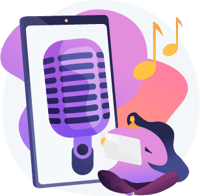 Long ago, before television, there was radio. With no video, images, or fancy graphics to lean on, radio hosts had to find ways to engage audiences for 30 to 60 minutes at a time and keep them coming back to hear more, day after day or week after week. Radio programs leaned on storytelling to pique and retain interest. To some degree, your podcast should do the same.
Long ago, before television, there was radio. With no video, images, or fancy graphics to lean on, radio hosts had to find ways to engage audiences for 30 to 60 minutes at a time and keep them coming back to hear more, day after day or week after week. Radio programs leaned on storytelling to pique and retain interest. To some degree, your podcast should do the same.
Think of each podcast episode as a chapter in a longer story told by your company or your brand. Maybe you want to demonstrate your company’s industry or product/service expertise. The story could include controversial and/or relevant topics, opinions from partners and other experts, and even little-known tips your company has learned and internalized.
Your podcast could also tell the story of your product or service: its evolution, usage, and value. For this type of story, you may need to dig into your company’s engineering or design team for guests, interview super-users, and talk to customer-facing teams.
Find ways to think out-of-the-box with your podcast story. Just remember to stay aligned with your purpose. At the end of the day, you’re creating a podcast to accomplish a goal that maps to your overall marketing strategy.
There’s no doubt that podcasts have caught on as an information and entertainment medium, and as a marketing tool. You can learn a lot from other podcast’s successes – and their mistakes.
Perform a competitive analysis of the podcasts in your industry that includes topics, story, reviews, and guests. You will quickly glean why some podcasts are wildly popular and why some have limited, if any, listenership.
While you’re there, pay attention of the podcast names in your space. Notice if there is a play on words or a name that hasn’t been thought of. Search across all podcasts to rule out any duplication of names you are considering.
Your research should include looking at keywords to identify topics that will resonate with your target audience. You can search Google AdWords, SEMrush, and Google Trends to determine what people are searching for. If you're an existing business with a blog (internal or external), your keywords and content are the low-hanging fruit of podcast topics, especially if they’ve already garnered attention from your target audience.
If you’ve followed our advice to create buyer personas, you’ll have learned which social media platforms they use and their posting habits, especially as they pertain to your company’s industry and the products or services you sell. Look through their reviews and comments on to discover more keywords.
The next step is to create the structural foundation for your podcast.
Your podcast structure should include format, name, tone, niche, and cadence.
Think about your favorite reality TV show. How would you describe it to someone who has never seen it? Is it a day-in-the-life, a POV, a game show, or some other set up? That description is the program’s format and is how the producers of the program organize what happens for every episode. Your podcast should have a format as well. Here are some of the most popular formats to consider:
![]() The INTERVIEW format is usually a two-person set up where the host asks questions and a guest with specific knowledge or expertise answers them. This format is a great option for hosts who are not comfortable talking for an entire podcast and can demonstrate a diversity of expertise. Interview format podcasts are the most common, so you run the risk of listeners having format fatigue. It’s also very reliant on guests who are dynamic speakers, since they will be doing most of the talking.
The INTERVIEW format is usually a two-person set up where the host asks questions and a guest with specific knowledge or expertise answers them. This format is a great option for hosts who are not comfortable talking for an entire podcast and can demonstrate a diversity of expertise. Interview format podcasts are the most common, so you run the risk of listeners having format fatigue. It’s also very reliant on guests who are dynamic speakers, since they will be doing most of the talking.
![]() The MONOLOGUE format is just that – one person speaking about their experience or expertise. While this format requires the least amount of coordination and creates intimacy with your target audience, it can become monotonous to always hear the same voice. Monologue format podcasts work best when the speaker has a natural affinity for humor or a knack for radio-worthy banter.
The MONOLOGUE format is just that – one person speaking about their experience or expertise. While this format requires the least amount of coordination and creates intimacy with your target audience, it can become monotonous to always hear the same voice. Monologue format podcasts work best when the speaker has a natural affinity for humor or a knack for radio-worthy banter.
![]() The CONVERSATIONAL format involves two hosts who have straightforward discussions about topics. This format works when both hosts are familiar with and on the same page about topics. It can be quite effective for creating a casual and entertaining environment.
The CONVERSATIONAL format involves two hosts who have straightforward discussions about topics. This format works when both hosts are familiar with and on the same page about topics. It can be quite effective for creating a casual and entertaining environment.
![]() The ROUNDTABLE format is much like the interview format but with more people. It gives your listeners the experience of overhearing a host-guided conversation. The robustness of multiple perspectives is a good way to listeners engaged. However, you’ll need to have a deep bench of guests.
The ROUNDTABLE format is much like the interview format but with more people. It gives your listeners the experience of overhearing a host-guided conversation. The robustness of multiple perspectives is a good way to listeners engaged. However, you’ll need to have a deep bench of guests.
![]() REAL-LIFE STORYTELLING is a great format to demonstrate how customers use your products and services, and it translates well for internal podcasts to promote corporate initiatives and company change. Keep in mind that this format must be well-produced to be effective.
REAL-LIFE STORYTELLING is a great format to demonstrate how customers use your products and services, and it translates well for internal podcasts to promote corporate initiatives and company change. Keep in mind that this format must be well-produced to be effective.
![]() The REPURPOSED CONTENT format leverages existing content from blogs or other media. It is a fantastic, low-budget format that’s easy to produce but may not offer as much value to your audience as original content.
The REPURPOSED CONTENT format leverages existing content from blogs or other media. It is a fantastic, low-budget format that’s easy to produce but may not offer as much value to your audience as original content.
Of course, you can create your own format, which will definitely be unique, but also adds more work to the planning process.
The right format for your podcast balances what resonates with your target audience and what you can realistically create and maintain.
Pull out that buyer persona document again and look at the types of media your target audience prefers. Notice if they tend to be more formal or casual. Their preferences and habits will shed light on which formats are most likely to engage your audience.
Do you have to pick just one format and stick with it? Ideally, yes. So, make sure you pick a format you can maintain easily. However, it doesn’t mean you can’t explore other options. Some very successful monologue podcasts bring on special guests or even a roundtable for special editions (like an end-of-year expert roundup, for example).
Next, you’ll need to determine which talent you use for the podcast. Is there a “personality” in your company who would be perfect to host the podcast? Do you have stories to tell that would be engaging for listeners? Will you have a full stable of guests for roundtables or interviews? What is the level of expertise among your hosts?
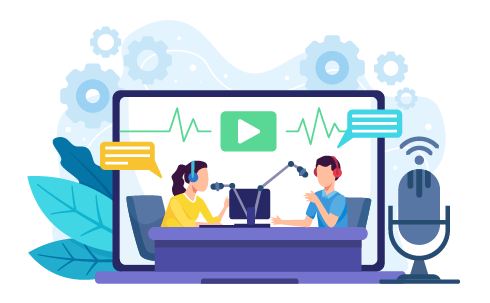
Choosing the length of your podcast has everything to do with your audience and their bandwidth. Busy entrepreneurs may only have 15 minutes of real listening time, so an hour-long podcast won’t keep their attention. Look at your target audience’s habits. Are they likely to listen in the car or on a train commuting to work? How long is that commute? If your target audience works from home, don’t assume they have unlimited time. Remote working has been completely transformed in the last year, and businesspeople working at home are juggling more than ever. Your podcast may still need to be abbreviated to earn listenership, loyalty, and achieve its goal.
The next element is the name of your podcast. This also includes your tag line and description. All three of these elements help the listener know what to expect from your podcast.
When it comes to selecting a podcast name, consider your audience and the format you’ve chosen. Of course, you’ll have to make sure there is no duplication. As well, look at online domains – is there anything available that works with your podcast’s ideal name?
With these things in mind, you can approach naming your podcast from three different perspectives: abstract, descriptive, or branded:
After you’ve named your podcast, you’ll need to identify a niche for your podcast.
To accomplish the goal you created for your podcast, you will need to take a position on something. Memorable podcasts aren’t wishy-washy or unbiased.
“It's an interesting phenomenon when it comes to podcasts,” Caitlin says. “Just like when you're marketing a business, sometimes you can get caught up in wanting to be everything to everyone, and you don't allow yourself to narrow your focus. But what actually happens is the opposite. You end up speaking to no one.”

“If you try to be everything to everyone with your podcast, you end up reaching no one.”
— Caitlin Sellers Castevens, Clariant Creative inbound marketing specialist, co-host of Lady Tech Charmers Podcast / @cscastevens
Also be wary not to jump on the bandwagon of trendy industry fads disguised as opinions. Your podcast needs to have staying power, and listeners know when a podcaster is not well-versed in a subject. It comes through by way of a lack of depth in the subject area. Your podcast niche should be something you or your guests are confident and comfortable talking about so the content is authentic and engaging.
You’ve got your point of view for the podcast. Now it’s time to identify tone.
The first question you should ask when deciding on the tone of your podcast: What will resonate with the target audience and engage them the most. How can the tone of your podcast set it apart from your competitors and the hundreds of thousands of podcasts available for listening? Will it be casual, formal, funny, or thought provoking?
It’s also important to make sure your podcast’s tone reflects your company’s culture (at the very least, it shouldn’t clash).
One of our clients at Clariant Creative recently launched a podcast that conveys the fun nature of the company’s culture. The hosts have great rapport, vibrant personalities, and are extremely engaging. The tone is lively and fun, even with content that is serious in nature. And every element of their podcast conveys this tone – graphics, visuals on the website, social posts, music, and even how the topics are approached.
The last element of your podcast’s structure is cadence.
Successful podcasts are consistent – they have a cadence that listeners become familiar with and quickly come to expect. Your podcast cadence determines how often you’ll need to record and publish a new podcast episode.
If you are confident in your team’s ability to create content consistently and you have the available resources, you can publish a new episode as often as every day. But, it can be time consuming and will easily require at least one dedicated resource. A daily cadence is often limited to monologue or conversational formats. It would be a Herculean task to publish a daily interview, panel, or real-life storytelling podcast, not to mention the amount of content you would need to have planned out ahead of time.
Regardless of the cadence you choose, you’ll need to create a schedule that corresponds to actual dates on a calendar.
Your podcast calendar combines all the structural elements into one source of truth that your team and leadership will use to stay on the same page. Here is an example of a podcast calendar that is easy to use and customize.
This Podcast Calendar Template has all the information you will need to keep your team on the same page. Download your copy today!
Get the Podcast Calendar Template

You could say that podcast episode planning is where the “rubber hits the road” in podcast best practices. Too often, podcasters do the big picture planning and then they either wing it or skim through the episode planning process. And it shows.
Listeners know when a podcaster is flying by the seat of their pants. The transitions are awkward and there is usually some amount of dead air. Host(s) and guest(s) can relax, follow the flow, and be present when podcast episodes are planned using best practices.
Regardless of your format, tone, niche or cadence, podcast episodes should always include six elements:
They don’t always have to follow the same order, but podcasts should always flow effortlessly. The magic of a great podcast episode comes from how clearly the content delivers on the episode name and description, and how well each element flows into the next, regardless of order.
“There is a ‘secret sauce’ to being able to hook people right away in the first few minutes,” says Caitlin. “You know it when it you’ve got it.”
If the flow doesn’t work when you play it back, you can always edit your podcast to rearrange soundbites, reduce or eliminate tangents, and delete bloopers. The key is to not create more work for yourself, which is where outlines and scripts come in.
To make sure your podcast episode flows, create an outline that organizes episode elements and highlights key messaging. Work with your team (and even guests) to refine the order of elements in your outline until there is a natural flow. From there, you can create a script.
Podcast episode scripts are not meant to be read word-for-word in a monotone voice. Instead, a script allows the host(s) and guest(s) to follow the outline in more detail so the episode flows as it should, resulting in less awkwardness and dead air.
“I use a script when I’m podcasting because I know I can go off on a tangent,” says Whitney. “A script helps me speak freely without the filler words that we all use when we’re thinking of what to say next.”
It’s easy to see how scripts are beneficial to solo and real-life storytelling formats. For formats that involve guests, which rely on a back-and-forth flow, a script can help develop the rapport that makes a podcast great. Give guests the opportunity to review an episode’s script so they can collaborate and add value to what will be discussed.
Of course, there will be candid moments and improvisation in any podcast episode. The script creates natural opportunities for those moments because it helps ensure that the host and guests stay true to the intended episode message and your overall goal for the podcast.
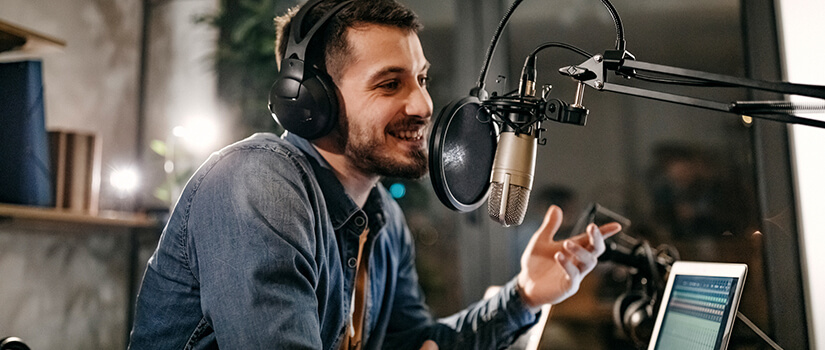
Before you rush to record your first podcast episode, you need to decide whether to outsource the production of your podcast.
For large companies that already produce videos and other media, it’s an easy no – unless the internal production team doesn’t have the bandwidth to take on an ongoing project of this scope. But for small and mid-size companies, the question requires some consideration.
Outsourcing your podcast production offers a number of advantages, especially when you have a team of one. Bringing in production expertise allows you to focus on being a host, generating content, and securing guests.
“A lot of people think, ‘Oh, you just record and go,’ but if you're doing this for business, there's a lot of different facets of it,” Whitney points out. “You have to do the recording, you have to do the scheduling, you have to do the editing, you have to do the social media, you have to do the distribution. There's so many different hats to wear in this process.”
 “Production involves recording, scheduling, editing, social media, and distribution. There are so many hats to wear in this process.”
“Production involves recording, scheduling, editing, social media, and distribution. There are so many hats to wear in this process.”
— Whitney Barkley, CEO of Speakerazzi, Host of Pink Lemonade Podcast / @whitneylbarkley
Another advantage to outsourcing is you’ll get a different perspective from third party professionals who can provide valuable feedback. Their suggestions are focused on producing the highest quality recording.
On the flip side, outsourcing means you’ll have to spend more time getting into a rhythm with external resources. The cost of outsourcing may also be prohibitive and may not be required if you’re doing a solo, conversational, or real-life storytelling podcast that doesn’t require as much set up or, hopefully, as much editing.
If you decide not to outsource, you’ll want to select your recording platforms, invest in a good microphone, and decide if you also want to record video.
When it comes to recording, many podcasters use Zoom, but the audio quality isn’t always reliable. Another options is Zencastr, which allows for remote recording with guests who can record separate audio files. The catch? You’ll have to do some editing.
Deciding on a microphone depends on where you are recording. If you are recording in a room that is soundproofed and has a music studio setup, a condenser mic is a great option because it can pick up a pin dropping. However, if you’re recording from your dining room, a dynamic mic will be better because it picks up audio from what is right in front of it. Even the way that the mic is positioned can affect how good or bad the audio quality is.
Your best bet is to do an online search, watch YouTube videos, and play around with different options to see how they sound. Once you get the sound you want, press record.
When it comes to editing, Audacity and GarageBand are fairly easy to use and downloadable for free. The Adobe suite or Adobe Audition are great options too with more advanced editing functions.

You’ve got a recorded and edited podcast episode. Congratulations! Now it’s time to publish and promote your podcast to start you on the way toward your goal. The first step is to choose a hosting service.
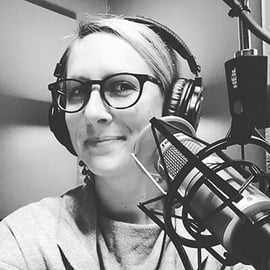 You have multiple options for hosting. The most popular podcast hosting service is Podbean, which has multiple hosting tiers including a free option. SoundCloud is probably the most user-friendly hosting site. One of the oldest hosting sites is LibSyn. While it isn’t as robust as the others, it is a reliable service and quite affordable.
You have multiple options for hosting. The most popular podcast hosting service is Podbean, which has multiple hosting tiers including a free option. SoundCloud is probably the most user-friendly hosting site. One of the oldest hosting sites is LibSyn. While it isn’t as robust as the others, it is a reliable service and quite affordable.
Next, create an RSS feed and submit your podcast to one of the publishing apps where users can listen and subscribe to your podcast:
Now it’s time to grow your audience. The podcast community is quite collaborative, so look for ways to cross-promote and encourage other podcasters to promote your podcast.
Here is a list of other ways you can promote your podcast:
Your podcast will undoubtedly contain a wealth of content you can leverage through other channels to generate leads and promote your podcast. Look for ways to repurpose your content as much as possible and across as many of your existing and new channels as possible. Examples include:
![]() Blog posts: Each episode can be repurposed into one or more blogs. You may have to do a little legwork to stretch your content into multiple blog posts, but the ROI will be worth it. Make sure to include a call to action (CTA) that links to one of the episodes.
Blog posts: Each episode can be repurposed into one or more blogs. You may have to do a little legwork to stretch your content into multiple blog posts, but the ROI will be worth it. Make sure to include a call to action (CTA) that links to one of the episodes.
![]() Pillar pages: Once you create enough blog posts on a particular subject, you can connect them and your podcast with a pillar page that will serve as a knowledge base of information on a topic. Your CTA should link to your podcast.
Pillar pages: Once you create enough blog posts on a particular subject, you can connect them and your podcast with a pillar page that will serve as a knowledge base of information on a topic. Your CTA should link to your podcast.
![]() Videos: One reason to consider recording video of your podcast is you can repurpose that video – on YouTube, TikTok, social medial channels, and your website. Make sure to link back to your podcast.
Videos: One reason to consider recording video of your podcast is you can repurpose that video – on YouTube, TikTok, social medial channels, and your website. Make sure to link back to your podcast.
![]() Web content: In addition to creating a web page for your podcast, add web pages related to your podcast's content, especially for guest formats where you’re learning new information that is of interest to your customers and potential leads.
Web content: In addition to creating a web page for your podcast, add web pages related to your podcast's content, especially for guest formats where you’re learning new information that is of interest to your customers and potential leads.
Tracking the success of your podcast goes back to your SMART goal, which should be detailed enough that you will know when you’ve accomplished it.
To know if you’re on the right track, however, you should establish incremental checkpoints. But what exactly do you track?
Podcast success can be measured by listens and downloads, which is a direct reflection of how large and committed your subscriber base is. If your goal is related to expanding into social media, the measurement of success may be a combination of listens, downloads, and social media engagement for each episode. Additional measurements can be related to reviews, comments, contacts influenced, and even leads.
“Success depends so much on how you’ve aligned your podcast goal with the buyers’ journey and your overall marketing strategy,” says Caitlin. “There is a plethora of KPIs and metrics you can match up to the journey your audience is taking.”

“Success depends on how you’ve aligned your podcast goal with your buyer’s journey and your overall marketing strategy.”
— Caitlin Sellers Castevens, Clariant Creative inbound marketing specialist, co-host of Lady Tech Charmers Podcast / @cscastevens

There are a number of ways to tie your podcast to your company’s sales strategy. Show notes and articles that address topics covered in your podcasts are great middle of funnel (MOF) activities that can convert guests to prospects.
You may also want to address market objections in your podcasts, treating it as a sales enablement tool to help close leads and deals. Success stories, interviews with your most successful clients, and case studies are all great ways to integrate your podcast into your sales process.
Launching a podcast requires work but it can definitely be a highly effective tool to help achieve your marketing goals. By following these best practices and engaging in thoughtful planning, you can develop a podcast that gets the right people listening, coming back for more, and loving your brand.
Clariant Creative is a full-service inbound marketing agency based in the western suburbs of Chicago, IL.
We help businesses create clarity in their marketing, so they can help their clients move forward with confidence.

Clariant Creative Agency, LLC
[fa icon="phone"] 630-330-9825
[fa icon="envelope"] info@clariantcreative.com
[fa icon="map-marker"] 1468 Ambleside Circle, Naperville IL 60540